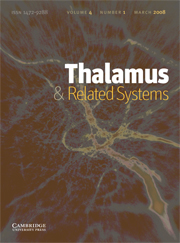Article contents
Rapid and lasting increase in serine phosphorylation of rat spinal cord NMDAR1 and GluR1 subunits after peripheral inflammation
Published online by Cambridge University Press: 11 October 2005
Abstract
Previous studies have demonstrated that peripheral inflammation leads to long-term increases in spinal dorsal horn neuronal excitability (i.e. central sensitization) and behavioral hyperalgesia that is mediated by glutamate receptor activation. The present study has examined spinal cord changes in serine phosphorylation of the NMDA receptor NR1 and AMPA receptor GluR1 subunits after peripheral inflammation. Using site-specific antibodies, Western blots showed a significant increase in phosphorylation at serine residues 896 and 897 of the NR1 and at serine residues 831 and 845 of the GluR1 subunits in the rat spinal cord after injection of complete Freund's adjuvant into the hindpaw. For all four serine sites, the increased phosphoserine NR1 and GluR1 levels occurred as early as 10 minutes, lasted for at least 3 days, and returned to control level 7–14 days following inflammation. There was also an increase in total NR1 and GluR1 proteins after inflammation, but with a different time course. The phosphorylation of different serine residues of NR1 and GluR1 depended on input from the injured site. Local anesthesia of the inflamed paw with lidocaine (2%), blocked the increase in phosphoserine 896 (NR1) and phosphoserine 831 (GluR1) with a time course corresponding to the duration of anesthesia. However, the increased phosphoserine 845 (GluR1) was blocked only transiently and the concentration of phosphoserine 897 (NR1) was not affected by local anesthesia. Consistent with previous biochemical analysis, phosphorylation of serine 896 NR1 and serine 831 of GluR1 was blocked by intrathecal chelerythrine (0.01–1 nmol), a PKC inhibitor, and phosphorylation of serine 897 NR1 was blocked by H-89 (0.01–1 nmol), a PKA inhibitor. In addition, there appeared to be an interaction between the PKC and PKA cellular pathways because phosphorylation of serine 897 of NR1, a substrate of PKA, was also blocked by chelerythrine. These findings correlate serine phosphorylation of the NR1 and GluR1 subunits to spinal hyperexcitability and hyperalgesia, and indicate a role of serine phosphorylation of NMDA and AMPA receptors in initiating central sensitization.
Information
- Type
- Research Article
- Information
- Copyright
- © 2005 Cambridge University Press
- 4
- Cited by

